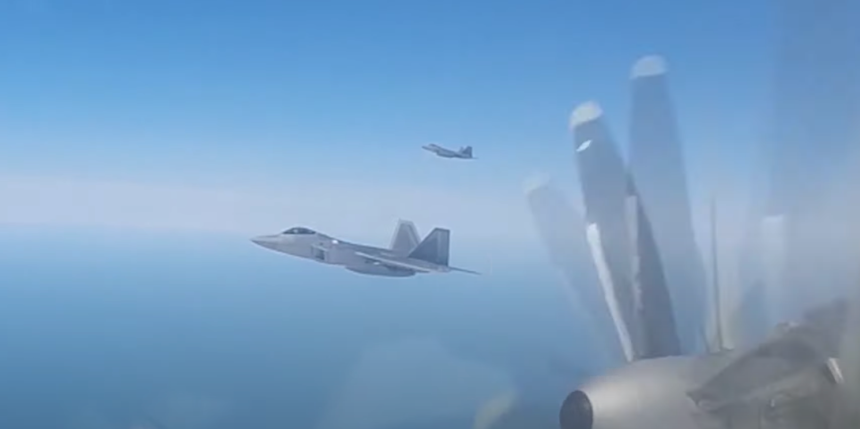Routine activity in the Alaskan Air Defense Identification Zone. The only interesting details this time, is that NORAD disclosed the distance from the “Alaskan shores” at which the Russian “packages” were intercepted.
On Jun. 10, 2020, U.S. F-22 Raptors, supported by KC-135 Stratotanker and E-3 Sentry AWACS aircraft, under NORAD (North American Aerospace Defense Command) control completed two intercepts of Russian formations entering the Alaskan Air Defense Identification Zone.
According to NORAD, “The first formation consisted of two Tu-95 bombers, accompanied by two Su-35 fighter jets and an A-50 airborne early warning and control aircraft, which came within 20 nautical miles of Alaskan shores. The second formation consisted of two Tu-95 bombers supported by an A-50 and came within 32 nm. The Russian military aircraft remained in international airspace and at no time did they enter United States sovereign airspace.”
The ADIZ, or “Air Defense Identification Zone”, where the intercept occurred is international airspace that extends 200 miles from the U.S./Canadian coastline and is monitored in the interest of national security. U.S. territorial airspace begins only 12 miles from the coastline. Usually, the Russian aircraft stay well clear of the 12-mile U.S. air space limit during their long-range exercises; in this case it at least worth of note that the U.S. Command released details about the distance at which the Russians were intercepted: respectively 20 and 32NM. It would be interesting to understand exactly which were the “Alaskan shores” skirted by the Russian package, to have a clear idea of the area where the intercept occurred: the Aleutinian islands, a chain of 14 large volcanic islands and 55 smaller islands, most of those belonging to Alaska, are quite far from the mainland.
North American Aerospace Defense Command F-22 Raptors, supported by KC-135 Stratotankers and E-3 Airborne Warning and Control System, completed two intercepts of Russian Bomber formations entering the Alaskan Air Defense Identification Zone early this morning.
— North American Aerospace Defense Command (@NORADCommand) June 10, 2020
As often explained in details, Bears sometimes fly near international borders along with Su-35s and A-50s to collect data about a country’s air defense network and to collect mapping and signals intelligence to build a communications and early warning “Order of Battle” so that radio and radar frequencies can be identified and cataloged for future use. The missions may happen periodically as the electronic order of battle is changed frequently to maintain operational security. Depending on the weather and time of day, the intercepts, when and if they happen, can produce incredible photos and video. The United States also conducts similar surveillance missions close to Russian airspace (and other areas of interest) for similar reasons.
A video of the intercept filmed from inside a Tu-95 was released by Russian Government sponsored Zvezda:
As per standard peacetime QRA (Quick Reaction Alert) procedures, F-22s carry out their intercept missions with radar reflectors and external fuel tanks as there’s no need for the fighters to fly in stealth mode, quite the opposite.










